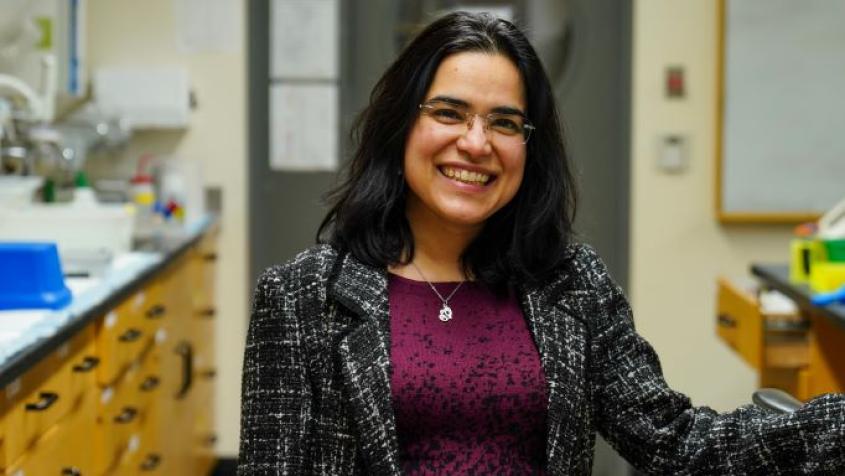New faculty: Dr. Richa Sardana
The Cornell University College of Veterinary Medicine (CVM) has recently welcomed many new faculty members to our academic departments and hospitals, each one bringing a unique set of skills and experience that enriches our college every day. In this Q&A series, you'll get to know their interests, expertise and more.
Dr. Richa Sardana, assistant professor, Department of Molecular Medicine
Q: What has been your path leading to Cornell?
I completed my Ph.D. in molecular genetics and microbiology at University of Texas-Austin, where I studied how ribosomes are assembled in eukaryotic cells in the lab of Dr. Arlen Johnson. Ribosomes are the molecular machines that synthesize all proteins in a cell, and their assembly is incredibly complex. I decided to shift my focus from the world of RNA to protein quality control for my postdoctoral training. After a brief stint at Stanford, I joined Dr. Scott Emr’s lab in the Weill Institute of Cell and Molecular Biology at Cornell to learn more about membrane protein quality control. I finally found my home in the College of Veterinary Medicine where I am an assistant professor in the Department of Molecular Medicine.
Q: What drew you to CVM?
My department in CVM provides a unique environment to study fundamental cell biological questions relevant to human and animal diseases, which is a great fit for my research. Also, the chair of my department, Dr. Maurine Linder, is a role model for me as a woman in STEM!
Q: What is your scientific area of expertise?
I study how membrane protein trafficking and quality control mechanisms ensure proper cellular function, and how their dysregulation results in diseases. We employ cell biological, biochemical and genetic approaches to study these fundamental mechanisms in yeast and human cell culture models.
Q: What drew you into this area? Any specific experiences, mentors or influences that helped guide you?
I have always been fascinated by and drawn toward questions of quality control of cellular processes, and how they operate at the molecular level. This interest has led me to seek mentors with a mechanistic focus to their research. Switching fields exposed me to different model systems and experimental skills and broadened my scientific perspective. This has often allowed me to be able to step back and appreciate the bigger picture. I am indebted to my mentors who have influenced my approach while giving me the freedom to chart my own course.
Q: What past professional work are you most proud of and why?
My postdoctoral work provided fundamental insights into how endo-lysosomal quality control employs a fail-safe mechanism to target topologically diverse cell surface membrane proteins for degradation in the lysosome. Explorations that followed from that project led me to look more closely at mechanisms of membrane protein trafficking and allowed me to focus on new questions that my own laboratory will explore in the future.
Q: What about your research are you most excited for, and why?
I am really excited to study how mechanisms targeting membrane proteins to their correct cellular location and those that identify and remove defective proteins work together to maintain cellular homeostasis.
Q: What impacts do you hope to see your work have on the world or on human/animal health?
Basic research on fundamental cellular processes is of profound importance to make meaningful advances in medicine. In the longer run, I want to understand how disruptions in protein homeostasis manifest in various diseases affecting human and animal health. I would love to work with clinical researchers at CVM to look at some of these mechanisms underlying diseases they encounter in the clinic.
Q: What scientific questions are you looking to answer next, or areas you plan to explore?
My research group will focus on uncovering the function of proteins in ensuring protein localization at specific cellular organelles such as the Golgi and the lysosomes. These proteins and pathways are conserved from simple single-celled organisms all the way to humans.
Q: What’s something most people don’t know about you?
I have painted a mural for the City of Ithaca! I like to paint, try origami paper folding and a bit of ceramics.
Q: What’s the best part of being a scientist?
To always learn new skills, and to be the first one in the entire world to discover something new. To be able to share that joy and train the next generation of scientists and pay it forward.
Q: What’s the most challenging part?
Persistence. Every successful discovery is a result of rigorous and iteratively improved experimentation. Keeping the morale high despite failures (which are numerous). Scientific research is also a lonely pursuit and feels more isolating if you are underrepresented. Finding ways and spaces to feel like you belong is difficult but important.
Q: What are the benefits of working at CVM? At Cornell?
The people at CVM and Cornell are welcoming and kind. The research environment is collaborative and new ideas and techniques are openly shared. My senior colleagues look out for me and are supportive. I also love the outdoors, and the idyllic setting of the Cornell campus in Ithaca. I walk on a hiking trail to get to work every day — that’s a dream come true!





